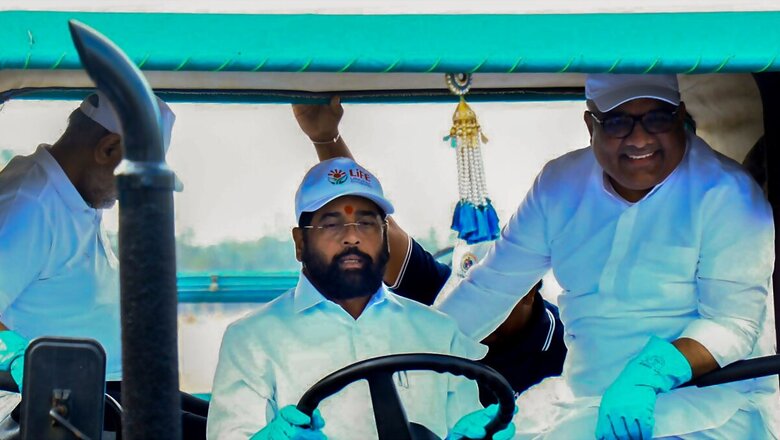
views
One of the key reasons for the delay in announcing Shinde as the Chief Ministerial candidate is to maintain strategic flexibility. Maharashtra is a politically complex state where voter sentiment can shift rapidly, and alliances can be fragile. This year’s scenario is completely different as two parties have split, with each faction of these two parties joining hands with the BJP in the state. By not locking in Shinde, the Mahayuti can keep its options open, allowing it to respond to any potential last-minute changes in the political landscape. In an election as unpredictable as this one, where new political narratives can emerge overnight, keeping the CM position open allows the alliance to make adjustments based on how the election campaign unfolds.
Another reason for holding off on the declaration is the need to balance power within the alliance. Eknath Shinde, after his dramatic rise to the Chief Minister’s position following the split in the Shiv Sena, has consolidated his leadership within the Mahayuti. However, the alliance also includes influential factions like the BJP and Ajit Pawar’s NCP, both of which have significant sway in the coalition. Prematurely announcing Shinde as the CM candidate could disrupt this balance, potentially alienating other key figures within the alliance who may want a say in the final decision. The Mahayuti leadership seems to be taking a careful approach, ensuring that all factions feel included in the post-election decision-making process, thereby maintaining internal unity and cohesion.
Delaying the CM announcement also serves a broader strategic purpose. By keeping the focus on the alliance’s collective agenda, rather than on a single leader, the Mahayuti ensures that the election doesn’t become centered around one individual. If the alliance were to declare Shinde as the CM candidate, it could potentially turn the election into a referendum on his leadership, which may limit the appeal to a broader electorate. By leaving the CM decision for later, the Mahayuti can concentrate on key issues such as development, governance, and infrastructure — areas where the alliance has a strong track record — rather than allowing the campaign to be overshadowed by a single personality.
Additionally, announcing a Chief Ministerial candidate too early can polarise voters. While Shinde enjoys significant popularity, particularly among his Shiv Sena base, certain segments of voters may resist backing him, especially in regions where caste or regional dynamics play a stronger role. By holding off on the announcement, the Mahayuti avoids early voter alienation, allowing them to focus on winning over undecided voters. It also provides room for the alliance to adapt its strategy should unforeseen challenges arise during the campaign.
Despite these political calculations, Eknath Shinde is a suitable candidate for the Chief Minister’s role. His rise from humble beginnings as a rickshaw driver to the highest political office in the state is nothing short of inspirational. Shinde’s personal journey resonates deeply with the people of Maharashtra, particularly with the common man who sees in him a reflection of their own struggles and aspirations. His humility, dedication, and ability to connect with the masses have earned him widespread respect and admiration. Shinde belongs to ‘Maratha Cast’ which is dominant in the state of Maharashtra. There are leaders like Devendra Fadnavis and Ajit Pawar who are senior to Shinde but Fadnavis has no backing of the Maratha Community. While he is deputy Chief Minister, the Maratha community has been questioning him about their reservation. Ajit Pawar is battling a fight for survival, especially after the poor show which his party experienced in Lok Sabha election. In such a scenario, Shinde has got the edge and if Mahayuti declared him as their CM candidate, he may walk that extra mile for them to attract voters towards Mahayuti.
Shinde has been directly involved in major infrastructure projects that have transformed Maharashtra, earning him the moniker “Infrastructure Man.” Projects such as the Samruddhi Mahamarg and Mumbai Metro expansion highlight his vision for a modernised Maharashtra. His administration’s focus on infrastructure development, coupled with his empathy for the struggles of farmers and the rural population, has made him a leader who balances urban progress with rural welfare. Moreover, Shinde’s ability to blend tradition with modernity strengthens his appeal across a wide spectrum of voters. As the torchbearer of the Shiv Sena’s Hindutva legacy, Shinde has remained true to the party’s roots while also modernising its approach for today’s electorate. His government’s commitment to preserving Maharashtra’s cultural heritage, alongside pushing for industrial growth and women’s empowerment through initiatives like the Majhi Ladki Bahin scheme, showcase a leader who is both rooted in tradition and forward-thinking.
Shinde’s strength as a crisis manager further solidifies his candidacy. He has repeatedly proven his ability to lead from the front during crises, whether in the wake of floods, droughts, landslides or even in case of Maratha agitation. His presence on the ground, addressing the concerns of affected people, reassures the public that their problems are being handled with urgency and care. Under his leadership, Maharashtra’s disaster management systems have seen significant improvements, preparing the state for future challenges.
While the Mahayuti may have strategic reasons for delaying the formal announcement of Eknath Shinde as its Chief Ministerial candidate, there is little doubt about his suitability for the role. His rise from the grassroots, his relentless focus on development, and his deep connection with the people of Maharashtra make him one of the ideal candidates to lead the state into the future. If the Mahayuti secures victory, Shinde is well-positioned to continue transforming Maharashtra with his dynamic leadership. But it’s no longer a secret that regarding leadership in Maharashtra, the final call will be taken by the BJP top leadership. Recently, during his Mumbai visit, Home Minister Amit Shah had said that in 2024, the Mahayuti will come to power and in 2029, the party will work to get BJP in power, which gives significant hint about what the party’s leadership thinks about the future.



















Comments
0 comment